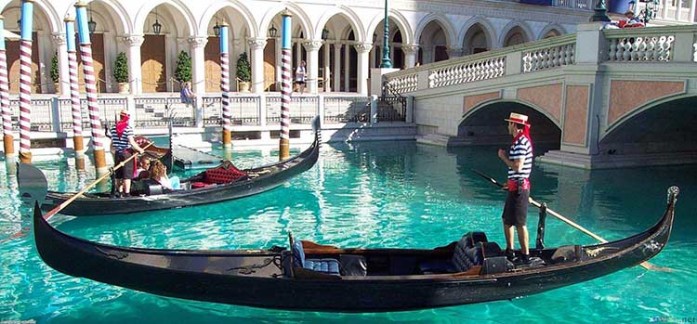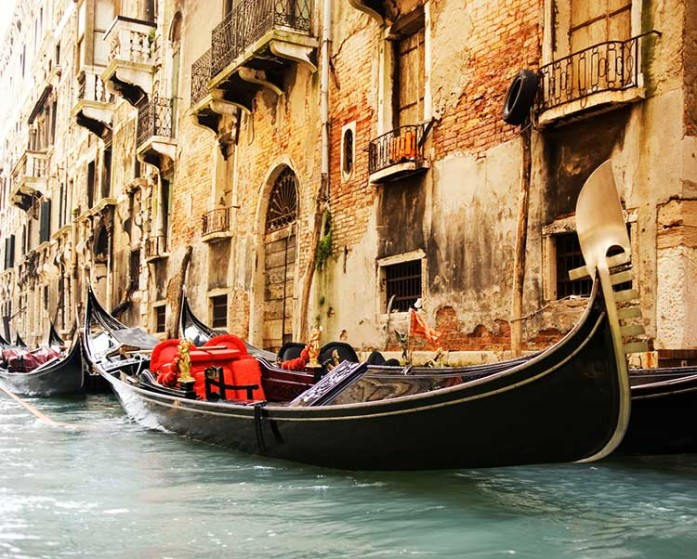The gondola is a traditional, flat-bottomed Venetian rowing boat, well suited to that conditions. The oar is not fastened to the hull, and is used in a sculling manner, also acting as the rudder. For hundred of years the gondola was the most common watercraft within the city of Venice. The guy who propels it is called a gondolier. In modern times the iconic boats still have a role in public transport in the city, serving as ferries over the Grand Canal. They are also used in special regattas held between gondoliers. Their primary role today is to carry tourists on rides at fixed rates.
The gondolier stands facing the bow and rows with a forward stroke, followed by a compensating backward stroke. The oar rests in an elaborately carved wooden rest (forcola) shaped to project from the side of the craft so as to allow the slight drag of each return stroke to pull the bow back to its forward course. Because of the vessel’s flat bottom it may also be “drifted” sideways when required. Contrary to popular belief, the gondola is never poled like a punt as the waters of Venice are too deep. The punt is another boat type on which the propeller (called “the punter”) generally propels the punt by pushing against the river bed with a pole, but this will be the subject of another article.
Gondola – A Historical Evolution
Until the early 20th century gondolas were often fitted with a small cabin, to protect the passengers from the weather or from onlookers. Its windows could be closed with louvered shutters—the original “Venetian blinds”. After the elimination of the traditional in response to tourists complaining that it blocked the view—there survived for some decades a kind of vestigial summer awning, known as the “tendalin”. While in previous centuries gondolas could be many different colors, a somehow “moral” law of Venice required that gondolas should be painted black, and they are customarily painted now all black.

Gondola
[source]
It is estimated that there were between eight to ten thousand gondolas during the 17th and 18th century. There are just over four hundred in active service today, virtually all of them used for hire by tourists. Those few that are in private ownership are either hired out to Venetians for weddings or used for racing. Even though the Gondola by now has become a widely publicized icon of Venice, in the times of the Republic of Venice it was by far not the only means of transportation: on the map of Venice created by Jacopo de’ Barbari in 1500 only a fraction of the boats are gondolas, the majority of boats are batellas, caorlinas, galleys and other boats – by now only a handful of batellas survive, and caorlinas are used also only for racing.

Gondola parked in Venice
[source]
The historical gondola was quite different from its modern evolution- the paintings of Canaletto and others show a much lower prow, a higher “ferro”, and usually two rowers. The banana-shaped modern gondola was developed only in the 19th century by the boat-builder Tramontin, whose heirs still run the Tramontin boatyard. The construction of the gondola continued to evolve until the mid-20th century, when the city government prohibited any further modifications.
Gondolas are hand made using 8 different types of wood (fir, oak, cherry, walnut, elm, mahogany, larch and lime) and are composed of 280 pieces. The oars are made of beech wood. The left side of the gondola is made longer than the right side. This asymmetry causes the gondola to resist the tendency to turn toward the left at the forward stroke.
If you like what you read, please subscribe to this blog by completing the form. If you want to help more, start by following us on Twitter, and like our page on Facebook. You don’t know what good things may happen. To lighten your day, check our pins on Pinterest, we can be friends there too. Oh, and if you need a really good looking blog attached to your site, or just for fun, to express your feelings more competitively, read this Own Your Website offer! Thank you very much.
